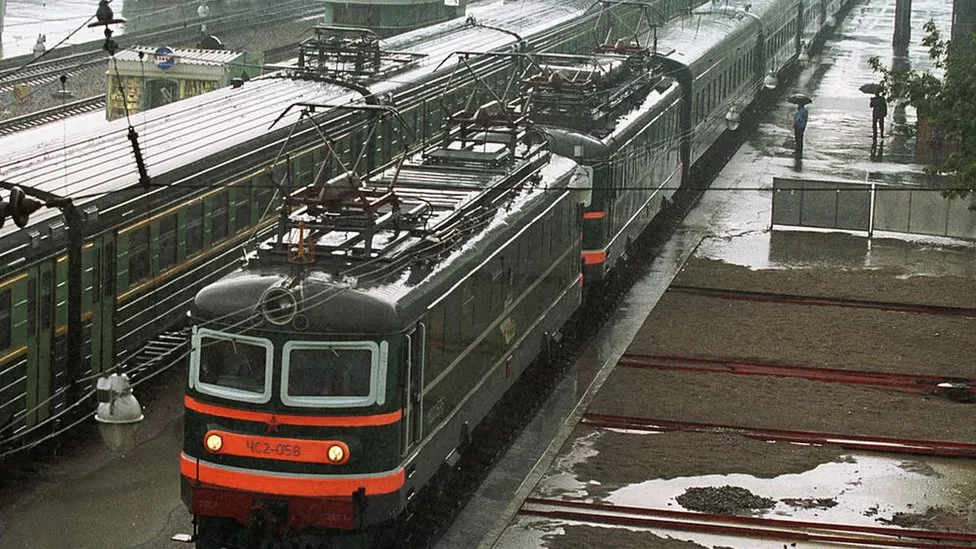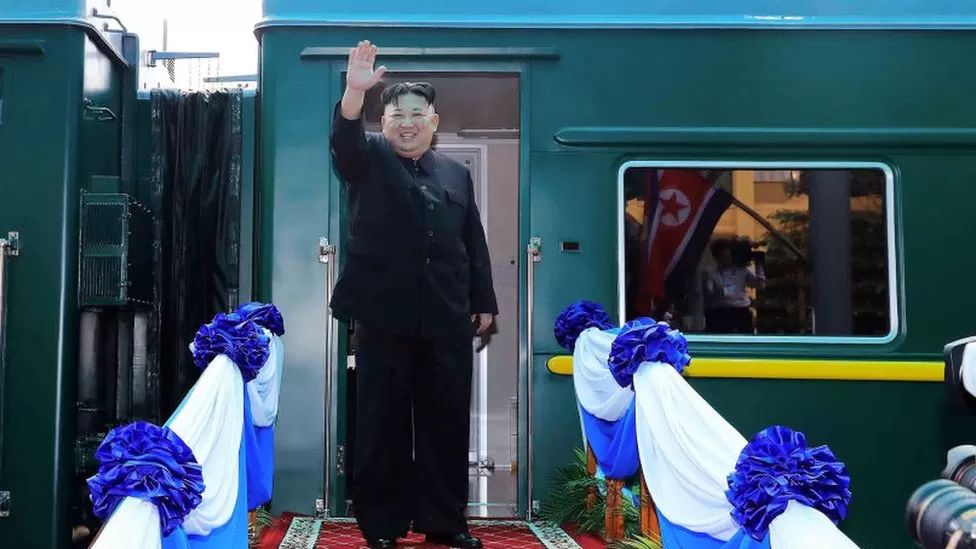North Korea's leader Kim Jong Un is on his way to Russia's port city Vladivostok via bulletproof train to meet President Vladimir Putin.
In line with a long-standing tradition among North Korean leaders, Mr Kim will likely spend over 20 hours travelling some 1,180km (733 miles) on the slow-moving locomotive – said to include a restaurant serving fine French wines and dishes such as fresh lobster.
The train rattles along at about 50km/h (31mph) because of its heavy armoured protection. By comparison, London's high-speed rail runs at about 200km/h while Japan's Shinkansen bullet trains can hit 320 km/h.
The long journey also takes into account the North's sometimes archaic rail network. The train has been christened Taeyangho, the Korean word for the sun, and a symbolic reference to North Korea's founder Kim Il Sung.
Time-honoured trains
The tradition of long-distance travel via train was started by Kim Il Sung – Kim Jong Un's grandfather – who took his own train on trips to Vietnam and Eastern Europe.
These luxurious trains are said to be heavily guarded by security agents who scan routes and upcoming stations for bombs and other threats. Kim Jong Un's father Kim Jong Il, who ruled North Korea from 1994 until his death in 2011, reportedly travelled by train because he was afraid of flying.
Kim Jong Il famously took 10 days to get to Moscow in 2001 to hold a meeting with Mr Putin. Russian military commander Konstantin Pulikovsky, who accompanied the former North Korean leader on the 2001 ride, spoke of its opulence in his memoir Orient Express.
“It was possible to order any dish of Russian, Chinese, Korean, Japanese and French cuisine.” He recalled live lobsters being transported to the train to ensure the availability of fresh delicacies, while cases of red wine from Bordeaux and Burgundy were also flown in from Paris.
Even Mr Putin's private train “did not have the comfort of Kim Jong Il's train,” he said. Another former Russian diplomat, Georgy Toloraya, wrote in 2019 about his experience of travelling on the same 2001 train ride. He recalled dishes considered delicacies such as donkey meat and abalones – a type of mollusc – being flown in from Pyongyang. Russian Standard vodka was also a fixture.

Both Russians described performers and singers entertaining guests aboard the train. North Korean state media said that Kim Jong Il died of a heart attack while travelling on the train in 2011.
In November 2009, conservative South Korean daily Chosun Ilbo reported that the armoured train featured around 90 carriages. The green vehicle with a yellow stripe also had conference rooms, audience chambers and bedrooms, with satellite phones and flat-screen televisions installed for briefings.
Other images show carriages filled with red leather armchairs. Kim Jong Un may not share his father's fear of flying, as he has flown on his Russian-made private jet for several trips.
But when he last met Mr Putin in Vladivostok in Russia's far east in 2019 – likely to be the last time Mr Kim travelled abroad – he also arrived by train. He was welcomed by officials with a traditional offering of bread and salt. His rumoured trip, if it happens, will most likely start in Pyongyang and go through Tumangang station at the Russian border, where wheels on the train will be switched for the Russian tracks.
The wheel switch is expected to take at least a few hours.
Private planes
In addition to trains, Mr Kim has also been seen getting about on other forms of luxurious transport that paint a sharp contrast to the impoverished lifestyles of the North Korean people.
Having attended boarding school in Switzerland, Kim Jong Un is no stranger to flying. In May 2018, he made his first international flight since assuming power, to the Chinese city of Dalian to meet Chinese President Xi Jinping.
Media reports suggest he has previously used his private jet for travel within North Korea. The aircraft that flew him to China was a Soviet-made long-range aircraft, the Ilyushin-62 (Il-62). North Korean watchers at website NK News say locals call it “Chammae-1” named after the goshawk, the country's national bird.
But when he last met Mr Putin in Vladivostok in Russia's far east in 2019 – likely to be the last time Mr Kim travelled abroad – he also arrived by train. He was welcomed by officials with a traditional offering of bread and salt.
His rumoured trip, if it happens, will most likely start in Pyongyang and go through Tumangang station at the Russian border, where wheels on the train will be switched for the Russian tracks.
The wheel switch is expected to take at least a few hours.
Private planes
In addition to trains, Mr Kim has also been seen getting about on other forms of luxurious transport that paint a sharp contrast to the impoverished lifestyles of the North Korean people.
Having attended boarding school in Switzerland, Kim Jong Un is no stranger to flying. In May 2018, he made his first international flight since assuming power, to the Chinese city of Dalian to meet Chinese President Xi Jinping.
Media reports suggest he has previously used his private jet for travel within North Korea.
The aircraft that flew him to China was a Soviet-made long-range aircraft, the Ilyushin-62 (Il-62). North Korean watchers at website NK News say locals call it “Chammae-1” named after the goshawk, the country's national bird.
Mr Kim's favoured S-Class model was prominent during the 2018 inter-Korean summit at Panmunjom, when he drove across the border with bodyguards running alongside. His convoy at the summit was also reported to feature a private toilet car, used by the leader to answer the call of nature while travelling.
This was also mentioned in a 2015 report by Seoul-based website DailyNK, which said that a customised bathroom is built into one of the cars of Mr Kim's convoy of armoured vehicles.
Mystery yacht
State media in North Korea have shown the leader riding on boats, a submarine, buses and even a ski lift. He is also rumoured to use other forms of transport, but these are yet to be seen in his excursions abroad.
When state media published photos of his visit to an army-run fishing station in May 2013, NK News observed a yacht in the background. There was no clear confirmation that the vessel, estimated to cost $7m, belonged to Mr Kim, or even how it was imported despite international sanctions on luxury goods.
Given the price, however, many international media outlets singled out the nation's ruler as the most likely owner. In June 2015, Washington-based Radio Free Asia reported that a researcher had spotted a new helipad at Mr Kim's lakeside villa in South Pyongan province.
The researcher, working at the US-Korea Institute of the Johns Hopkins School of Advanced International Studies, suggested that the helipad may be used by Mr Kim's family or visitors.
— CutC by bbc.com


